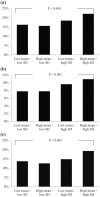Mean and variability of annual haemoglobin A1c are associated with high-risk peripheral artery disease
- PMID: 32148085
- PMCID: PMC7510362
- DOI: 10.1177/1479164120909030
Mean and variability of annual haemoglobin A1c are associated with high-risk peripheral artery disease
Abstract
Background: Glucose variability is predictive of cardiovascular events and all-cause mortality. However, the association between peripheral artery disease and glucose variability has not been thoroughly investigated. Therefore, the standard deviation of annual haemoglobin A1c was assessed in patients with type 2 diabetes for evaluating the different risks of peripheral artery disease.
Methods: A total of 4144 patients underwent an evaluation for the ankle-brachial index and the percentage of mean arterial pressure at the ankle. The first haemoglobin A1c record was retrospectively collected from each year until the ankle-brachial index measurement.
Results: The standard deviation of annual haemoglobin A1c was higher in patients with ankle-brachial index ⩽0.90 than in those with ankle-brachial index >0.90 (1.1 ± 0.9% vs 1.0 ± 0.8%, p = 0.009) and was higher in patients with percentage of mean arterial pressure ⩾45% than in those with percentage of mean arterial pressure <45% (1.1 ± 0.8% vs 1.0 ± 0.8%, p = 0.007). A high standard deviation and mean of annual haemoglobin A1c are associated with high-risk peripheral artery disease, which is defined as a combination of ankle-brachial index ⩽0.90, percentage of mean arterial pressure ⩾45% or both (odds ratio = 1.306; 95% confidence interval = 1.057-1.615; p = 0.014).
Conclusion: Fluctuation in the haemoglobin A1c value indicates higher risk for peripheral artery disease in patients with type 2 diabetes and poor glucose control.
Keywords: Ankle-brachial index; haemoglobin A1c; percentage of the mean arterial pressure; peripheral artery disease; type 2 diabetes; variability.
Conflict of interest statement
Figures



Similar articles
-
Use of the ankle-brachial index combined with the percentage of mean arterial pressure at the ankle to improve prediction of all-cause mortality in type 2 diabetes mellitus: an observational study.Cardiovasc Diabetol. 2020 Oct 9;19(1):173. doi: 10.1186/s12933-020-01149-7. Cardiovasc Diabetol. 2020. PMID: 33036608 Free PMC article.
-
Relationship of Hyperglycaemia, Hypoglycaemia, and Glucose Variability to Atherosclerotic Disease in Type 2 Diabetes.J Diabetes Res. 2018 Jul 22;2018:7464320. doi: 10.1155/2018/7464320. eCollection 2018. J Diabetes Res. 2018. PMID: 30140707 Free PMC article.
-
Haemoglobin A1c variability as an independent correlate of atherosclerosis and cardiovascular disease in Chinese type 2 diabetes.Diab Vasc Dis Res. 2018 Sep;15(5):402-408. doi: 10.1177/1479164118778850. Epub 2018 May 31. Diab Vasc Dis Res. 2018. PMID: 29848065
-
Pitfalls in hemoglobin A1c measurement: when results may be misleading.J Gen Intern Med. 2014 Feb;29(2):388-94. doi: 10.1007/s11606-013-2595-x. Epub 2013 Sep 4. J Gen Intern Med. 2014. PMID: 24002631 Free PMC article. Review.
-
Glucose Variability and Coronary Artery Disease.Heart Lung Circ. 2019 Apr;28(4):553-559. doi: 10.1016/j.hlc.2018.10.019. Epub 2018 Nov 12. Heart Lung Circ. 2019. PMID: 30527849 Review.
Cited by
-
HbA1c variability predicts cardiovascular complications in type 2 diabetes regardless of being at glycemic target.Cardiovasc Diabetol. 2022 Jan 24;21(1):13. doi: 10.1186/s12933-022-01445-4. Cardiovasc Diabetol. 2022. PMID: 35073913 Free PMC article.
-
Epidemiology and Burden of Peripheral Artery Disease in People With Type 2 Diabetes: A Systematic Literature Review.Diabetes Ther. 2024 Sep;15(9):1893-1961. doi: 10.1007/s13300-024-01606-6. Epub 2024 Jul 18. Diabetes Ther. 2024. PMID: 39023686 Free PMC article. Review.
-
Depressive Symptoms Associated with Peripheral Artery Disease and Predicting Mortality in Type 2 Diabetes.Biomedicines. 2023 Dec 21;12(1):29. doi: 10.3390/biomedicines12010029. Biomedicines. 2023. PMID: 38275390 Free PMC article.
-
Use of the ankle-brachial index combined with the percentage of mean arterial pressure at the ankle to improve prediction of all-cause mortality in type 2 diabetes mellitus: an observational study.Cardiovasc Diabetol. 2020 Oct 9;19(1):173. doi: 10.1186/s12933-020-01149-7. Cardiovasc Diabetol. 2020. PMID: 33036608 Free PMC article.
-
Causal associations between HbA1c and multiple diseases unveiled through a Mendelian randomization phenome-wide association study in East Asian populations.Medicine (Baltimore). 2025 Mar 14;104(11):e41861. doi: 10.1097/MD.0000000000041861. Medicine (Baltimore). 2025. PMID: 40101035 Free PMC article.
References
-
- American Diabetes Association. 9. Pharmacologic approach-es to glycemic treatment: standards of medical care in diabetes-2019. Diabetes Care 2019; 42: S90–S102. - PubMed
-
- Takao T, Matsuyama Y, Yanagisawa H, et al. Association between HbA1c variability and mortality in patients with type 2 diabetes. J Diabetes Complications 2014; 28: 494–499. - PubMed
-
- Orsi E, Solini A, Bonora E, et al. Haemoglobin A1c variability is a strong, independent predictor of all-cause mortality in patients with type 2 diabetes. Diabetes Obes Metab 2018; 20: 1885–1893. - PubMed
Publication types
MeSH terms
Substances
LinkOut - more resources
Full Text Sources
Medical

